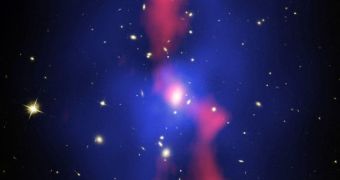After processing new readings gathered from various space- and Earth-based telescopes and observatories, astronomers now say that the energy that a black hole can unleash is sufficient to wipe out the galaxies around them, and send “death waves” for millions of light-years around the blast zone. All black holes at the center of galaxies fire out powerful plasma jets that reach impressive distances in length and can annihilate everything in their path. However, what causes them is still unknown.
There are only two theories as to what is causing these emissions – one states that they result from matter being sucked into the black hole, while other experts say that the energy is generated by the huge spinning force each of these celestial bodies have. A new discovery, the MS0735.6+7421 galaxy, may hold the final answer to this riddle. Observations have shown that current plasma jets of the black holes give out an energy reading roughly equivalent to 1055 joules, which is billions of times the power of a supernova.
Basically, this means that a single supermassive black hole at the center of a galaxy can release the same energy into its surroundings as billions of supernova stars, which are renowned for their powerful outbursts of energy. Needless to say, the discovery has left astronomers wondering about what other mysteries black holes hide, following a recent string of uncoverings that have thoroughly changed the international perception on the matter.
“It would have had to essentially vacuum all of the matter that was in that galaxy down into the black hole in a period of 100 million years, and we know nature doesn't work that way. Accretion of matter onto a black hole is very inefficient,” researcher Brian McNamara from the University of Waterloo, in Canada, says when talking about the fact that the energy output is millions of times greater than the matter entering the black hole inputs.
In case of a major energy release, black holes could sterilize their galaxies, basically stripping them of their potential to create life. When such massive amounts of energy are released, they blow away or destroy all gas they encounter, thus leaving stellar nurseries without the very thing they need in order to produce more solar systems.

 14 DAY TRIAL //
14 DAY TRIAL //